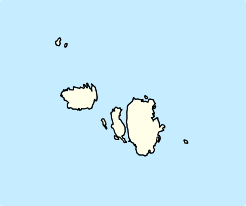
Ertholmene is a small archipelago in Denmark. The largest island is Christiansø, and its name often refers to the entire archipelago. Ertholmene is situated 18 kilometres (11 mi) northeast of Gudhjem, Bornholm, and contains Denmark's easternmost point. Two of its islands, Christiansø and Frederiksø, are inhabited, and their combined permanent population is 89. The archipelago has a total area of 39 hectares. Its name is derived from the Danish for "pea islands".
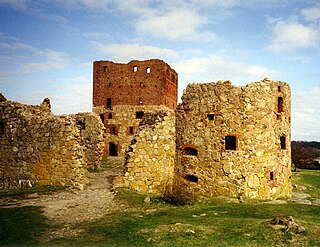
Hammershus is a medieval era fortification at Hammeren on the northern tip of the Danish island of Bornholm. The fortress was partially demolished around 1750 and is now a ruin. It was partially restored around 1900.

Bornholm Museum is a cultural history museum located in Rønne, Denmark. The museum collects, preserves, researches, and exhibits artifacts in order to raise awareness of Bornholm's cultural heritage.

The Kunstmuseum Basel houses the oldest public art collection in the world and is generally considered to be the most important museum of art in Switzerland. It is listed as a heritage site of national significance.

Danish art is the visual arts produced in Denmark or by Danish artists. It goes back thousands of years with significant artifacts from the 2nd millennium BC, such as the Trundholm sun chariot. For many early periods, it is usually considered as part of the wider Nordic art of Scandinavia. Art from what is today Denmark forms part of the art of the Nordic Bronze Age, and then Norse and Viking art. Danish medieval painting is almost entirely known from church frescos such as those from the 16th-century artist known as the Elmelunde Master.

The Bornholm school of painters (Bornholmerskolen) started to take shape towards the beginning of the 20th century on the Danish island of Bornholm when a number of artists developed a distinctive style of classic modernism, inspired by the island's unique landscapes and light. It was not characterized by a uniform artistic line, but rather by its experiments with color, abstraction and cubism.
Niels Lergaard was a Danish painter. He was a member of the Bornholm school of painters.

Gudhjem is a small town and fishing port on the northern coast of the Baltic island of Bornholm, Denmark. Its population is 736.
Harald Leth was a Danish painter whose Naturalistic work was inspired by Johannes Larsen of the Funen Painters and Oluf Høst of the Bornholm School.

Karl Oscar Isakson was a Swedish painter who spent much of his professional life in Denmark where he is considered to be one of the fathers of Modernism. He had close associations with the Bornholm school of painters and made many paintings of Christiansø. He is cited as an artist who "sought to give their Biblical works a modern social and political context."

Jørgen Haugen Sørensen was one of Denmark's most eminent sculptors. He had his artistic debut at the acclaimed and prestigious Spring Exhibition (Forårsudstillingen) at Kunsthal Charlottenborg, Copenhagen in 1953. Haugen Sørensen was a member of the artistic union Decembristerne and the artist collective Grønningen, as well as Veksølund in Denmark.

St. Clement's Church is a parish church located in the village of Klemensker on the Danish island of Bornholm. Completed in 1882 in the Historicist style, it replaces an earlier Romanesque church from the 14th century or earlier. Today the church is noteworthy for works contributed by the Bornholm artist Paul Høm. A number of runestones have been found in the neighbourhood, two of which are now in the churchyard.
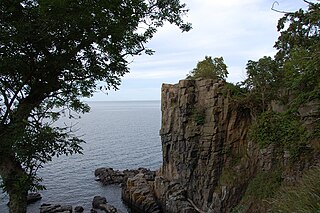
Helligdomsklipperne are a group of rocks on the island of Bornholm, Denmark, 6 kilometres (3.7 mi) from Gudhjem and 4.9 kilometres (3.0 mi) from Tejn. They are characterised by moderately high coastal cliffs of sharp granite and are about 22 metres (72 ft) high. The name of the rocks originated in the Middle Ages when there was a holy spring close to the coast which attracted pilgrims, especially on Sankt Hans Aften. During the ice age, much of today's coast was below sea level but when the ice melted, the island itself was raised leaving this part of Bornholm's coast some 20 meters above sea level. Coastal cliffs with deep caves and steep craggy granite pillars are typical of this area of the coast as a result of many years exposure to the weather. To the southeast the Kyststi or coastal path leads to the well preserved Døndalen Woods. It is a popular tourist attraction, accessed by boats from Gudhjem harbour. Steps lead from the coast up to the Bornholm Art Museum.
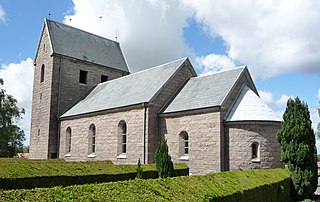
Rø is a small village on the Danish island of Bornholm, 2 km from the north coast and 7 km west of Gudhjem. The Rønne–Allinge railway (1913–1953) brought prosperity to the village leaving the old station in the village. The Bornholm Art Museum is close to Rø as are the scenic Sanctuary Rocks.

The Oluf Høst Museum is located on Løkkegade Street in Gudhjem on the Danish island of Bornholm. It is dedicated to Oluf Høst (1884–1966), one of the island's most famous artists, and includes an exhibition of some of his paintings. It was established in 1998 by converting Høst's old house where he lived and painted from 1929 until his death in 1966, and where he created most of his paintings around the Nordic theme of light and landscape. Selsø is situated at an elevation of 19 meters.
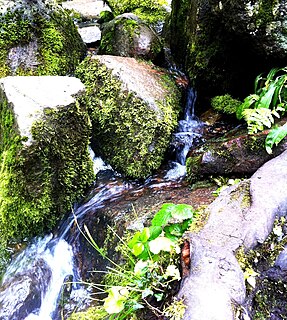
Døndalen is a valley in the northern part of the Danish island of Bornholm. Located next to the road from Gudhjem to Tejn, it is known for its waterfall, which is Denmark's longest.

Tejn Mølle, also known as Melsted Stubmølle, is a post mill on the Danish island of Bornholm. It was recently moved from Tejn on the west coast to Melstedgård near Gudhjem where it is part of Bornholms Landbrugsmuseum.
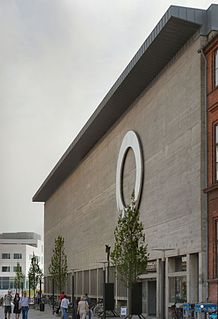
Randers Museum of Art is a Danish art museum in Randers in northeastern Jutland, Denmark. The museum is located in the cultural centre of Kulturhuset in the town centre and displays many of the major works of Danish painters, especially those of the 19th and 20th centuries.

Johannes Knud Ove Jais-Nielsen was a Danish painter, designer and ceramist, best known for the religious figure groups that he designed for the Royal Copenhagen pottery.

The Esbjerg Art Museum is an independently owned art museum in Esbjerg in southwest Jutland, Denmark. Founded in 1910, in 1962 it moved into a new building in the City Park designed by Jytte og Ove Tapdrup. Since 1997, the museum has formed part of a complex which also contains the Esbjerg Performing Arts Centre.

























